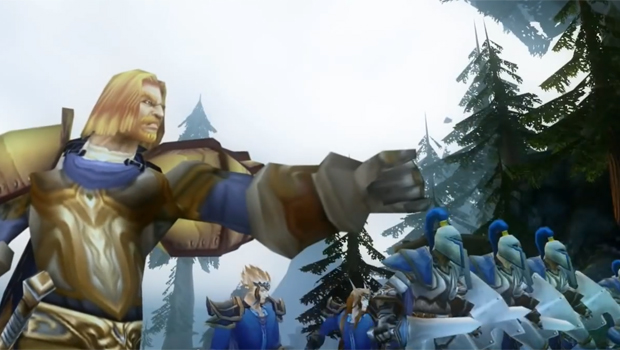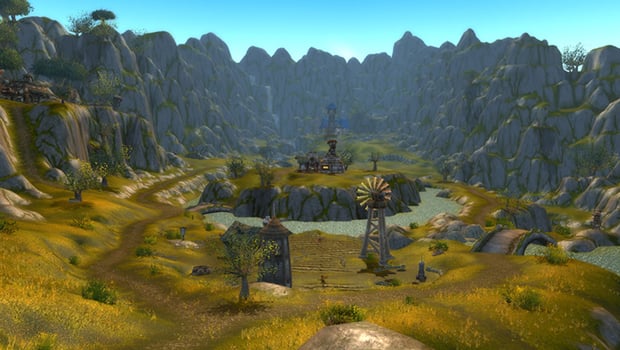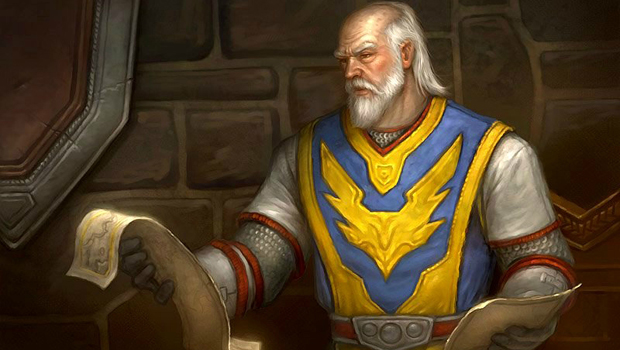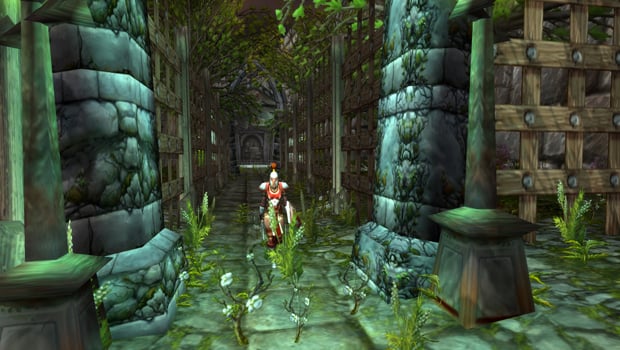Know Your Lore: The Arathorian Empire
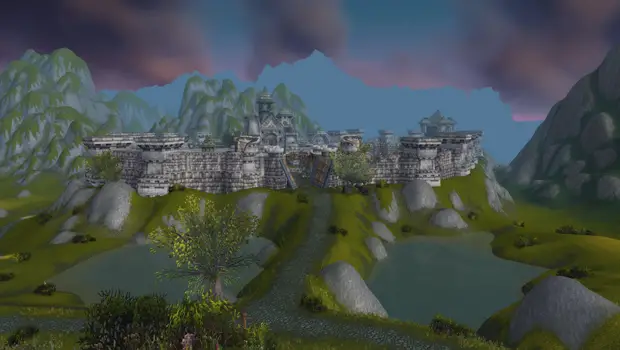
In last Sunday’s Queue, we had a couple of interesting comments — one a request, one a reply.
I’m never really one to back down from a challenge, especially one surrounding one of the most history-laden zones in the game. So today we’re going to talk about the Arathi Highlands, because while the in-game zone didn’t really get any kind of sweeping reconstruction with the Cataclysm revamp, it’s still important, in a major way. In fact, it was essentially the cornerstone for human history on Azeroth as we know it today, it was responsible for one of Azeroth’s most well-known, beloved heroes, and for some, it remains a haunting reminder of an empire lost to time.
Human history received an enlightening update when Wrath of the Lich King was released — the origins of the human race were finally revealed to Alliance players who leveled through the Howling Fjord. Humans are the byproduct of the Curse of Flesh, just like the dwarves and the gnomes, a descendant of the vrykul race that inhabits Northrend. At some point after Azeroth was created and ordered, prior to the War of the Ancients, the vrykul began having children that were smaller and far weaker than their parents. Although King Ymiron ordered these aberrations killed, not everyone obeyed this command. Instead, they took their children south, hiding them away to grow and thrive. These were the first of the human race — and when the War of the Ancients concluded and Kalimdor was sundered apart, the humans were left standing on the Eastern Kingdoms.
During this period of time, the humans thrived, forming tribes and settling along the continent. Of these many tribes, the most notable were the Arathi, led by Thoradin. Thoradin was a man with a problem and a plan to solve it — the trolls in the area presented a constant threat not just to his tribe, but to all human tribes. But if Thoradin managed to unify the scattered human tribes, the troll threat could easily be dealt with. So Thoradin set about conquering these neighboring, scattered tribes, but offered peace and equality to those he defeated, instead of wiping them out. The tactic worked, eventually bringing them all together as one mighty nation. Thus, Arathor was born, and the Arathorian Empire began in earnest.
Alliances
Soon enough, the human nation swept over a gigantic chunk of the Eastern Kingdoms, stretching from the Arathi Highlands all the way across to what we’d later see develop into Hillsbrad Foothills and Lordaeron. In Arathi, a capital city was founded: Strom. From within its mighty walls, Thoradin led the new Empire as its king. The trolls, in the meantime, had been successfully pushed back to the borders of the ever-expanding kingdom. Yet the humans weren’t the only target for the trolls — the Amani Empire was decidedly not happy about the fact that high elves chose to build the kingdom of Quel’Thalas on sacred troll land. The high elves had been fighting the Amani on and off for four thousand years during the Troll Wars.
And unlike Arathor, the high elves were beginning to lose that battle. Despite all the magic the quel’dorei possessed, the Amani had simply lain in wait, bolstering their numbers until they were strong enough to charge into high elf land and tear the high elves apart. Anasterian Sunstrider had little choice in the matter — the high elves needed allies, they needed them fast, and conveniently enough the humans to the south seemed to have banded together into a gigantic army that was successfully keeping the trolls at bay. Anasterian sent ambassadors to Strom to speak with King Thoradin, asking for an alliance and offering a tantalizing trade in return: One hundred humans would be taught the arcane arts, how to wield and use magic.
King Thoradin didn’t care for the idea of magic. He didn’t like the idea of humans learning spellcasting. But he was smart, and he realized what would happen if the high elves were left to fall. The Amani would reclaim their sacred lands, and immediately turn their attention on the next tempting threat — Arathor. And if the high elves, wielding impossibly strong magic that the humans could barely begin to comprehend, failed to hold the Amani at bay, then it didn’t really matter how many tribes he collected under the Arathor banner. Eventually, human civilization would fall. By allying with the high elves, he was not only getting rid of a potential threat the human nation had been battling on and off for years, he was also further bolstering his defenses and insuring that future attacks could be dealt with both by powerful armies and magic users at his disposal.
Victory
Between the might of Arathor and the forces of the high elves, the war came to a swift and abrupt end. The Amani Empire was left in ruins, broken and scattered, forced into the wilderness. The high elves of Quel’Thalas were victorious, and owed it all to the humans of the Arathorian Empire — a fact that did not escape Anasterian Sunstrider, who in gratitude pledged a vow of loyalty to the nation of Arathor, and to the bloodline of King Thoradin. However, it turned out Thoradin was probably right to be wary about his people learning magic — after the Troll Wars had ended, the spellcasters decided to splinter off by themselves and form their own city-state where they could study and refine their skills with the arcane. They called it Dalaran, and although they still held great respect for Strom and Arathor, it spelled the beginning of the end for the Arathor nation.
One by one, more city-states were formed — Gilneas, Alterac, Kul Tiras. All supported Strom, but Strom itself was beginning to fall into decline as more and more humans took their leave. Eventually, Strom itself came into contention — while the heirs of King Thoradin did not want to abandon the old capital, the lords of Strom disagreed. They left, traveling far north of Dalaran and eventually establishing what would become Lordaeron. Mighty Strom, once proud citadel of a powerful empire, was left with only the last descendants of the Arathi who had formed its walls so long ago. And eventually, they too left its hallowed halls, traveling south of Khaz Modan and eventually settling and establishing Stormwind.
As for Strom, few warriors still remained, ever devoted to guarding the ancient walls of the once-great city. No longer the center of an empire, it became its own kingdom, called Stromgarde. By the time the Second War rolled around, Stromgarde was led by Thoras Trollbane and allied closely with Lordaeron. Stormwind, to the south, had been decimated in the First War, its survivors traveling to Lordaeron for shelter, led by one notable, extraordinary man — Anduin Lothar, the last true descendant of the ancient Arathi bloodline. Having successfully ushered the survivors to Lordaeron, Lothar appealed to King Terenas for help and told his tale to all who would listen. This resulted in the formation of the Alliance of Lordaeron — the first iteration of the Alliance as we know it today. Lothar managed to bring the high elves into the alliance because of his bloodline — the long-standing debt to King Thoradin would at last be repaid.
Second and Third Wars
The Second War ended in a defeat for the Horde, but it wasn’t without its casualties. In Strom, Thoras Trollbane realized Alterac was not as allied as it pretended to be. Lord Perenolde of Alterac had allowed the orcs passage though mountain passes that would lead them straight to Lordaeron. Trollbane and his men quickly put an end to that plan, and at the end of the war, he asked King Terenas to give a portion of Alterac’s territory to Stromgarde in recognition for what they had accomplished. Not only was he not given the land, he discovered that Terenas had no intention of killing the orcs captured during the Second War, instead keeping them contained in internment camps. This was enough as far as Trollbane was concerned — Stromgarde officially withdrew from the Alliance of Lordaeron, following in the footsteps of Gilneas and Quel’Thalas.
The Third War didn’t affect Stromgarde nearly as badly as Gilneas, Lordaeron, and the other northern kingdoms. Trollbane and his troops managed to stave off the lands from the Scourge, and even sent a contingent of troops to Kalimdor with Jaina Proudmoore. Despite these successes, the kingdom met with tragedy when Thoras Trollbane was assassinated under mysterious circumstances, leaving his son, Galen Trollbane, to rule in his place. The last remnants of Stromgarde now had to deal with encroachment from both nearby Boulderfist ogres, and the Syndicate — a criminal organization created by the former Lord Perenolde and Alterac’s fallen nobles, intent on taking their revenge on Stromgarde for its part in Alterac’s fall.
Prince Galen fought valiantly to save his home, but parts of the city were soon taken over. And that wasn’t all — a member of the Horde was after Trol’kalar, a legendary weapon once wielded by Ignaeus Trollbane during the Troll Wars so long ago. It was buried with Thoras after his death, sealed away in a tomb that could only be opened with a collection of sigils guarded by Stromgarde’s strongest. The last of the sigils was held by Galen himself, and he was slain by the Horde for it. Stromgarde, it seemed, was nothing more than the crumbling remnants of what it had once been.
Ashes
Little remains to remind the world of what Stromgarde — Strom — used to be. The walls are largely fallen now, overrun with ogres and Syndicate alike, neither of whom have any real understanding of just where it is that they stand. Anduin Lothar met his end during the Second War, the last blood of Thoradin’s line spilling into the soil, never to be passed on. The only survivor left of the Trollbane line is Danath Trollbane, stationed at Honor Hold in Hellfire Peninsula and theoretically the last heir to Stromgarde’s throne, if he wishes to claim it. But many might wonder why he would bother, with the state that Stromgarde is in now. The remnants of Stromgarde’s citizens have retreated and gathered at Refuge Pointe, to hopefully wait for Danath’s arrival.
Stromgarde, and by extension the Arathi Highlands, may not seem like much to most people — there is little in the way of human civilization beyond a well defended burrow and the villains that still crawl the Highlands in search of easy targets. But this stretch of land, unremarkable as it may seem now, once held the cradle of humanity. It was the beginning of everything the Alliance is, everything that the human race has accomplished over the course of Warcraft‘s timeline. Absolutely nothing in Warcraft — both the MMO and the RTS games — would have been possible without Arathi or King Thoradin. Would it be cool to see it restored? Oh you bet it would.
If Danath returned, if Stromgarde were to be re-established, it would immediately be a force to be reckoned with. Restored, its shining halls would be the lone standing kingdom left in the upper portion of the Eastern Kingdoms — the only bastion against Sylvanas’ grasp, which has been slowly extending over the entirety of Lordaeron and the surrounding areas. If Stromgarde could be rebuilt, if it could hold its land, then perhaps Gilneas too could regain a foothold, bolstered by both Stormwind to the south, and Stromgarde to the east. And the idea of that reclamation, of humanity rising against all odds and coming together to triumph, is pretty much the ideal of what the Alliance is supposed to be. It’s what Arathor was, in its day — a bastion of humanity united in peace and equality, bound together against the threats that beckoned from the shadows, stalwart and strong.
Until then, we’ll have to patiently wait and hope to see that glorious day that Strom rises anew.
Please consider supporting our Patreon!
Join the Discussion
Blizzard Watch is a safe space for all readers. By leaving comments on this site you agree to follow our commenting and community guidelines.
 @Shadesogrey
@Shadesogrey